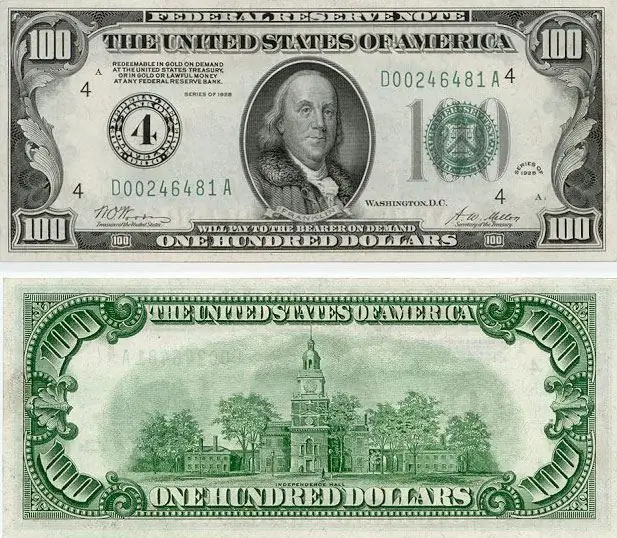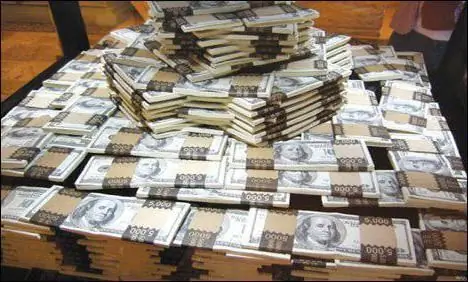2026 Author: Howard Calhoun | [email protected]. Last modified: 2025-01-24 13:10:31
Russia's gold and foreign exchange reserve is a strategic reserve in the form of precious metals, diamonds, major convertible foreign currencies, reserve positions, special drawing rights, and other highly liquid assets. It can be used by state structures of monetary regulation to maintain the exchange rate of the ruble, finance the balance of payments deficit, and support the domestic economy. Consists of the reserves of the Government (Ministry of Finance) and the Central Bank.

The laws of the market do not imply a stable, predictable, planned course. On the contrary, peaks, recessions, cyclical development are natural for the modern world economy. In order to mitigate the consequences of a sharp drop, fuel the financial system, stimulate production, many countries accumulate part of their funds in national gold and foreign exchange reserves. Their global supply is equivalent to $12 trillion.

Size by country
Russia's gold and foreign exchange reserves in 2014 (as of August 1)were equal to 468.4 billion dollars. This is the sixth indicator among all countries. Such a significant amount allows one to relatively painlessly endure economic downturns, invest in long-term promising projects, and use funds in emergency situations. It should be noted that the stock at this historical stage is decreasing (by 4 billion in the last week of July).
- The largest savings in the world "locomotive" - the People's Republic of China. The country is building up its strategic reserve. It increased by 3.09% in 2013, reaching $3.8 trillion.
- Japan has three times less reserves: in February 2014 they amounted to $1.288 trillion.
- The European Central Bank had $771.789 billion in reserves at the beginning of 2014.
- More than Russia's foreign exchange reserves, Saudi Arabia and Switzerland's.
- The US reserve in February 2014 amounted to $146.057 billion (18th).

Structure
The principle of forming a "gold and currency basket" implies the presence in the reserve of the most liquid currencies, monetary gold and other precious metals, international financial assets. The exchange rates are interconnected, so if one currency in a pair becomes cheaper, the second becomes proportionally more expensive. As a result, the reserve fund loses nothing. The structure of Russia's gold and foreign exchange reserves is constantly changing, following the trends in the global economy. Previously, the basis of the reserves were precious metals and the US dollar. With the introduction of the common European currency, the eurosignificantly pressed the dollar.
Too high dependence on the US dollar is forcing countries to diversify their reserves. Russia proposes to interested states to accept (create) an alternative global currency. At the same time, the share of currencies of other leading countries in the basket is expanding. For example, the reserve was significantly replenished with the Canadian dollar, the British pound, the Japanese yen.
- The share of foreign currency is about 85%. For example, in the 1st quarter of 2013, 44.7% was the US dollar, the euro - 40.3%, the pound sterling - 9.9%, the Canadian dollar - 2.3%, the yen - 1%.
- Monetary gold - 8.9%.
- Special Borrowing Facilities - 2%.
- IMF reserve positions - 1%.

Gold reserves
Russia's gold and foreign exchange reserve is based not only on foreign currency. Diamonds and precious metals are also included in the structure of the reserve. These are ingots of gold, palladium, silver, platinum. Gold is the most popular long term investment. Although its market value is subject to large fluctuations, in a crisis, the "yellow metal" becomes the most reliable means of payment.
Countries differently evaluate the expediency of accumulating funds in gold bars. On the one hand, they are irreplaceable in conditions of a serious economic crisis and a possible war. On the other hand, they lie in storage as a dead weight, instead of working for the economy. For example, in the United States, more than 70% of the reserve is gold, while China has 1.1%. Russia by gold reservesthe leader in the CIS - 1040.7 tons. However, it is 8 times less than stored in the US.
Gold reserves, 2014
| Country | Percentage of the country's total foreign exchange reserves | Gold, in tons |
| USA | 71, 7% | 8133, 5 |
| Germany | 67, 8% | 3386, 4 |
| Italy | 66, 7% | 2451, 8 |
| France | 65, 6% | 2435, 4 |
| China | 1, 1 % | 1054, 1 |
| Russia | 8, 9 % | 1040, 7 |
Dynamics
The economy of the Russian Federation is mostly built around the extraction and sale of raw materials. The government has taken a principled position - it wants to move away from the resource-based economy model and develop high-tech production. This will take years and multi-billion investment. So far, Russia's foreign exchange reserve is based on the sale of minerals and their derivatives. A significant share in exports is hydrocarbons (oil, gas), oil products and metals.
If we analyze the gold and foreign exchange reserves of Russia, the dynamics can be clearly seen. It strongly depends on the market situation for raw materials in the world, especially in Europe, the main consumer of Russian gas and oil. For example,in 1999, the historical minimum of the reserve fund was recorded - 10.7 billion dollars. That same year, oil prices were at their lowest in 25 years, hovering around $10 a barrel.

Historic high
By 2007 there was a sharp demand for oil. In July 2008, the record price of the "OPEC basket" (the arithmetic average of prices per barrel of different grades of oil) was recorded - $140.73. The cost of gas is pegged to the price of oil, respectively, and it has skyrocketed. The government was not ready to master the rushing flow of currency. It was decided to accumulate part of the windfall profits in the gold and foreign exchange reserve. In August 2008, Russia's gold and foreign exchange reserves reached a historic high of $598.1 billion.
Today
The current foreign policy situation and the decline in prices for natural resources are forcing the government to use part of the reserves to maintain the economy, strengthen the army, and ensure food security. If Russia's gold and foreign exchange reserves in 2014.03.07 amounted to 494.6 billion dollars, by August they had dropped to 468.4 billion. It is obvious that there are no reserves for their increase in the near future. However, the net size of gold and foreign exchange reserves is not an indicator of the efficiency of the economy. If funds are spent on modernization, scientific research, invested in investments, then the money spent today will return tomorrow in the form of new technologies, modern production, improving living standards, and increasing the country's security.
Recommended:
The size of the dollar in millimeters. Do banknotes vary in size?

What is the size of the US dollar in millimeters? Does the size of a banknote depend on its denomination? What is the rarest currency in the United States? Why is 1 dollar the most common in the world, what is the reason for this? Circulation of the monetary unit outside the country and within it
Gold and foreign exchange reserves of the countries of the world. What is it - a gold and foreign exchange reserve?

Gold and foreign exchange reserves are the reserves of foreign currency and gold of the country. They are kept in the Central Bank
Reserves of banks and their formation. Required bank reserves and their norm

Bank reserves ensure the availability of funds for the uninterrupted fulfillment of payment obligations regarding the return of deposits to depositors and settlements with other financial institutions. In other words, they act as a guarantee
Organizational structure of Russian Railways. Scheme of the management structure of Russian Railways. Structure of Russian Railways and its divisions

The structure of Russian Railways, in addition to the management apparatus, includes various dependent divisions, representative offices in other countries, as well as branches and subsidiaries. The head office of the company is located at: Moscow, st. New Basmannaya d 2
Gold and foreign exchange reserves of Ukraine: statistics and structure

Ukraine's gold and foreign exchange reserves have been declining since 2011. The falling trend indicates the inability of the state to maintain the national currency and the unsatisfactory state of the country's economy

